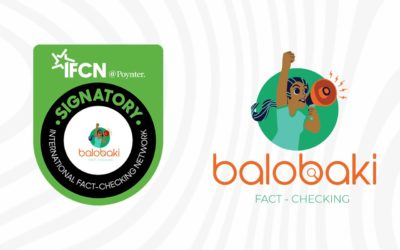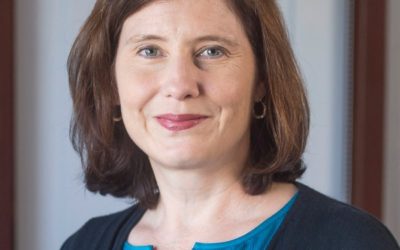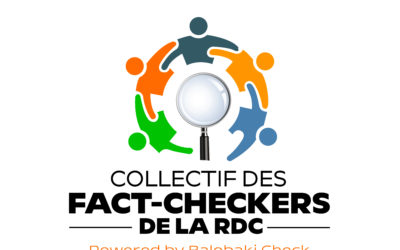By Ange Kasongo Adihe (Balobaki Check, RDC) et Valdez Onanina (Africa Check, Afrique francophone) – Translated by Helen Vesperini
In the Democratic Republic of Congo (DRC), the occupation of the towns of Goma and Bukavu by the rebels of the March 23 Movement (M23), supported by Rwanda, has been accompanied by an intensification of another form of conflict in the eastern zones: an insidious battle fuelled by disinformation. Unfounded rumours, alarming announcements of imminent attacks and the dissemination of images that are sometimes manipulated or taken out of context not only sow confusion, but also exacerbate an already fragile situation.
_____________________________________________________________________________________________________________________
Context
The M23 is mainly made up of mutineers from the Forces armées de la RDC (FARDC, the Congolese regular army), many of whom come from the ranks of the Congrès national pour la défense du peuple (CNDP). According to a fact sheet from the Office for the Coordination of Humanitarian Affairs (OCHA), the agreements of 23 March 2009, which gave rise to the M23 rebellion, include a clause providing for a new territorial division based on ‘the need to take better account of the country’s sociological realities’. The agreements also recognise the provinces of North and South Kivu as ‘disaster areas’, calling for inclusive development projects, with priority given to the worst affected areas. They also provide for the integration of CNDP members into the FARDC and the Congolese national police, as well as an amnesty for crimes committed between 2003 and the signing of the agreement in 2009.
The key dates in the M23 offensive in the east of the DRC
20 November 2012. The M23 rebels take control of the town of Goma for the first time. In October 2013, following the success of the FARDC supported by UN peacekeepers, the M23 laid down its arms. An agreement signed on 11 November 2013 commits both parties to ending the violence in eastern DRC.
November 2021: the M23 resumes attacks in several territories of North Kivu.
October 2022. Capture of the strategic town of Rutshuru and the town of Kiwanja by the M23, which controls part of national road n° 2 linking Goma, Beni and Butembo.
July 2024. Signing of a ceasefire effective 4 August, following a humanitarian truce. Despite this, the M23 continues to advance into Masisi territory in North Kivu.
December 2024. Attempts at mediation between Kinshasa and Kigali fail at the Luanda summit, due to the absence of Rwanda, which demands direct dialogue between the DRC and the M23.
January 2025. The M23 reached and occupied Goma, causing a massive displacement of the population, with 700 people killed and 2,800 wounded in the clashes.
February 2025. M23 advances as far as Bukavu in South Kivu.
________________________________________________________
For more information, read, DRC: What the M23 rebels are demanding
______________________________________________________________
Joséphine Kahambu, a resident of Butembo, is worried about her children. The messages spread through WhatsApp groups only increase her concern. ‘Last night, I read on a group that a man had been killed, and now I’ve been seeing videos of civilians being killed for four days. I have four sons, so if the M23 insurgents reach Butembo, it will be a tragedy for my family’, she laments. She is thinking of leaving the town if the M23 advances towards the Grand Nord, the name given to the northernmost part of North-Kivu province. As of 14 March, the town of Butembo was still under the control of the Congolese government.
In Goma, where Jean Christophe lives, the announcement of the death of the military governor, General Peter Chirimwami, on 24 January 2025, further disturbed a population already in panic because of the spectre of the M23, which finally took control of this strategic town four days later.
Jean Christophe was the only person in his family to use the telephone from the moment the FARDC confirmed the death of the military governor. ‘What Goma went through during those four days was horrible, I had confiscated the phones of my three teenagers, I wanted to be the only one to answer their questions at that time,’ he said.
The DRC does not have a law on access to information. In October 2024, national deputy Jacques Djoli tabled a bill in the National Assembly on access to information and transparency in public life in the DRC, but it has not yet been adopted.
Lack of reliable and impartial information delayed departures before the arrival of the rebels and hampered humanitarian efforts
‘I trusted the authorities, who kept saying that Goma would never fall. I was reassured in thinking that, in addition to the FARDC, we could count on the presence of SADC forces, Burundian soldiers, Romanians and even Monusco’, says Nadine, a mother of three living in Goma. Left alone with her children, she was unable to leave the town before the rebels arrived.
Why disinformation threatens humanitarian operations in restive DRC

Emergencies Conflicts Democratic Republic of the Congo
Workers unload food from WFP trucks at the Bulengo camp for displaced people, just outside North Kivu’s provincial capital of Goma. Eastern DRC is a patchwork of territories controlled by armed parties WFP must navigate. Photo: WFP/Shelley Thakral
The Democratic Republic of the Congo (DRC) accounts for one of the world’s largest internal displacement crises, with a stunning 6.5 million people uprooted. The majority are spread across four eastern provinces, where non-state armed groups proliferate and conflict rages. But there’s another threat to humanitarian access in the region: disinformation. WFP.org caught up with Wilfred Nkwambi, head of the World Food Programme’s (WFP) northeastern Goma area office, in North Kivu province, to learn more.
Be careful! Hate speech of a tribal nature undermines national cohesion
« We saw looting and acts of mob justice fuelled by misinformation. In Goma, all it took was one person in a crowd to raise a case based on false information for the whole population to support the idea”, said Fidel Kitsa, a fact-checker journalist based in Goma.
Another confirmed that intimidation had led journalists to censor themselves. ‘The threats have encouraged the dissemination of false information, because some journalists are afraid to report the truth for fear of being accused of collaborating with the rebels, especially with the threat of the death penalty. Some are still worried, like the journalists who have left Goma to take refuge in Beni’, said a representative of an online media outlet.
Media censorship fuels people’s concerns and undermines their understanding of events
In a press release dated 30 January 2025, Christian Bosembe, President of the Higher Audiovisual Council (CSAC) in the DRC, ordered the media to refrain from broadcasting information about the war raging in the east of the country without referring to official sources, on pain of sanctions that could include withdrawal of the signal or closure of the media outlet.
Three weeks earlier, the Congolese Minister of Justice, Constant Mutamba, had said on X: ‘Any political player, civil society member, journalist or religious figure who relays the activities of the Rwandan army and its M23 auxiliaries will henceforth suffer the rigour of the law (DEATH PENALTY)’.
______________________________________________________
Read more: DRC : Regulator accused of intimidating the press
______________________________________________________
Quotes
The head of a local radio station in Goma described the adjustments that have been necessary since the arrival of the AFC-M23 in the city. ‘The arrival of AFC-M23 in Goma has forced us to readjust our editorial lines. We no longer talk about rebels or the war of occupation, but about the armed forces of the AFC-M23’, he explained. Franck, a journalist working at a community radio station, also testified to the pressure exerted by the CSAC and the Congolese government.
In his view, these measures have given rise to a form of revolt. ‘We had to devote ourselves to transmitting authentic information, without any patriotic filter or compromise on the truth. Whether we like it or not, or whether Kinshasa dislikes it, we have chosen to inform the public openly’, he says with determination.
_______________________________________________
Authors’ note: SADC stands for Southern African Development Community. On March 13, 2025, the heads of state of the countries in this region announced the end of the mandate of the military force deployed by SADC in the east of the DRC after a mission lasting more than a year.
__________________________________________________
The DRC does not have a law on access to information. In October 2024, national MP Jacques Djoli tabled a bill in the National Assembly on access to information and transparency in public life in the DRC, but the law has not yet been adopted.
_____________________________
Read: INFO SHEET – Mapping texts and laws promoting access to public information in Africa
_____________________________
The lack of a legal framework guaranteeing access to clear and reliable information increases the vulnerability of communities around the world to misinformation. In the east of the DRC, where conflict and insecurity prevail, this legislative vacuum allows rumours and false information to spread even more rapidly and widely. For example, in some cases, communities have been encouraged to flee their homes following erroneous information about the imminent advance of the rebels.
The other plausible consequence is that such a situation could lead to inter-community tensions. The absence of verified and balanced information has sometimes led to unjustified accusations, triggering acts of violence or mob justice.
This context not only destabilises the social climate, but also complicates the humanitarian response. For example, NGOs have reported situations where misinterpreted or intentionally manipulated messages have fuelled mistrust of humanitarian actors, slowing down their response.
Without access to credible information, communities find themselves disorientated and exposed to decisions based on misleading information. This situation further weakens the social fabric already tested by the violence and makes stabilisation efforts even more difficult to implement in such an unstable context.
_________________________________________________




0 Comments